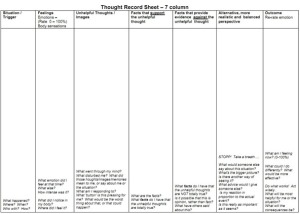A month ago I posted about Cognitive Behavioral Therapy and
the connection between our thoughts, feelings, and behaviors. We each have some distorted or irrational thought patterns, and this can lead to a lot of negative feelings about ourselves, situations, or others (and can also lead to symptoms of things like anxiety and depression). I’ve found with my clients that we can talk all we want about changing thinking patterns, but it’s really hard to do at first if we just
think about it. That’s why I encourage my clients to externalize those thought patterns and write them down. It’s easier to see and change patterns when they are external to us, and once we practice them, we can internalize them. I liken it to the idea of math time tests. While time tests were certainly not fun to do over and over again, it helped those equations to become natural and automatic. Now, we have to expend almost no energy because we immediately know what 2+2 is. That’s our goal with healthy thought patterns as well. Last week I talked about the
REBT self help form which can help to process the thought, feeling, behavior connection. Today I am going to talk about another form that I use on an almost daily basis with clients: The
Thought Record Sheet.

This form asks a number of questions to help walk you through identifying your current emotion and thought, as well as asking you to gather support for and against the disturbing thought. It then has you write a new, more healthy thought, and re-rate your emotion based on the new thought. It takes a few minutes, but the more you do it the more automatic your new healthy and rational thought will be. The goal isn’t to make things a fake happy, because that’s not realistic either. It’s ok for a situation to be frustrating, but this form helps keep the views balanced and rational. By keeping a log like this, it’s easy to track triggers for our stress, anxiety, or depression and allows us to prepare in advance of those situations. Even if you aren’t struggling with anxiety or depression, this form can still be of great use as we each have distorted thoughts from time to time.
The faster you can catch these thoughts and re-write them into a more balanced and realistic form, the more healthy you will think, feel, and behave! Externalizing your thoughts and slowing down to fill out the form can also keep you from quickly snowballing or jumping to conclusions. You can
click here for a PDF of the thought record sheet that you can print off and keep available for your stressful moments.
On a personal note, going through this process has made a big difference in my own life. While I don’t necessarily fill out this form much anymore, I’ve practiced it numerous times and am often able to catch those patterns when I say them and am then able to change it to something more realistic.
Now it’s your turn to share! How might you be able to use a thought record in your life? Can you identify any common negative beliefs that you hold onto in your life?
Disclaimer: This post is not meant to take the place of a therapist or doctor. If you are experiencing anxiety or depression, please talk to your doctor or a local counselor. If you are experiencing suicidal thoughts or have a plan, please call 911, go to the hospital, or call your doctor or therapist.
Related
Thanks for giving me the link to this post, Caroline. I find that it really helpful to track when I’m having anxious thoughts because it helps me identify what external factors are causing the feeling at that exact moment.
[…] stress, anger, anxiety, and depression in our lives. Using things like the REBT Self Help Form and The Thought Record can help us decrease unhelpful and unhealthy […]